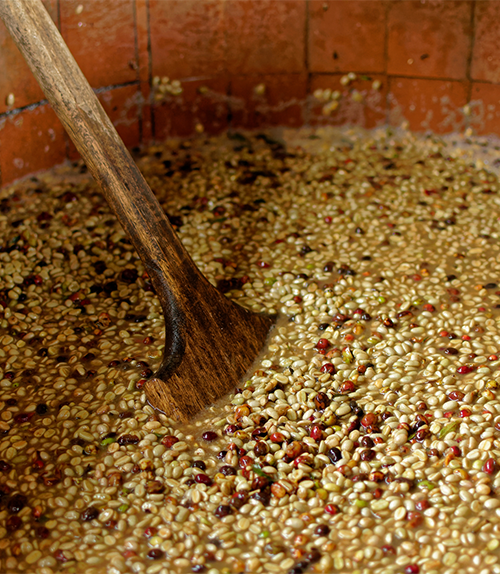Introduсtion
From the lush coffee farms to that steaming cup of morning magic, every step in the life of a coffee bean is a captivating dance of science and artistry. One particularly enchanting part of this journey is coffee fermentation, a critical process that shapes the rich, complex flavors and aromas we cherish in our brew. Dive with us into the vibrant world of coffee fermentation, where we unlock the secrets behind the beans!
The Science Behind the Sip: Fermentation Demystified
Coffee fermentation is like nature’s magic trick, transforming raw beans into a flavorful symphony. It involves microorganisms such as bacteria and yeast, breaking down organic substances in two distinct ways: aerobic (with oxygen) and anaerobic (without oxygen). Each method gifts the coffee with unique taste profiles.
Aerobic Fermentation
Aerobic fermentation occurs with a breath of fresh air—literally! Here, microorganisms use oxygen to break down the sugars in the mucilage (a sticky layer around the coffee bean), resulting in sunshine-bright, fruity flavors, and releasing aromatic compounds and carbon dioxide. It’s a fast fermentation process that infuses the beans with a lively zest.
Anaerobic Fermentation
Anaerobic fermentation is the quieter sibling, unfolding without oxygen. Microorganisms that thrive in zero-oxygen environments, like certain yeasts and lactic acid bacteria, perform this slower process. The result? A tantalizing range of flavors from sweet and fruity to deep and spicy, depending on the specific microorganisms involved and the fermentation duration.
Fermentation in Action: Processing Methods Unveiled
Different coffee processing and fermentation methods set the stage for diverse flavor profiles. Let’s explore the primary methods:
Natural/Dry Processing
Natural processing is a slow romance between the coffee cherries and the sun. Here, cherries dry with their mucilage intact, undergoing spontaneous fermentation as they bask in the warmth. This process can take weeks but results in beans bursting with intense, fruity flavors and a fuller, heavier body.
Washed Processing
Washed processing is like a precision ballet. After pulping the cherries to remove the skin, the beans (still covered in mucilage) are placed in fermentation tanks. The controlled fermentation breaks down the mucilage, making it easier to wash off, leading to cleaner, brighter flavors in your cup.
Anaerobic Fermentation
A modern twist in coffee processing, anaerobic fermentation involves sealing the cherries or beans in airtight containers, away from oxygen. This controlled environment creates pronounced and vibrant flavors, often more complex and captivating than traditional aerobic methods.
Conclusion
Coffee fermentation is a pivotal act in the grand production of coffee, significantly shaping the brew’s flavor and quality. Understanding these intricate methods can deepen our appreciation for the complex tapestry that is your cup of joe. From age-old natural and washed processes to innovative anaerobic techniques, the journey through coffee fermentation promises endless possibilities of delightful and memorable coffee experiences.
Faqs
Here are the FAQs:[/vc_column_text][vc_toggle title=”Q1: How do different fermentation methods impact flavor?” el_class=”faq_blog”]Different fermentation methods can produce a fantastic spectrum of flavors. Aerobic fermentation tends to deliver bright, fruity notes, while anaerobic fermentation can yield deeper, sweeter, and more complex tastes. The specific methods and conditions used can drastically influence the final flavor profile of the coffee.[/vc_toggle][vc_toggle title=”Q2: Does fermentation enhance coffee flavor?” el_class=”faq_blog”]Definitely! Fermentation enhances coffee flavor by developing a variety of aromatic compounds and affecting the acidity, sweetness, and body of the coffee. Properly controlled fermentation can add complexity and depth, making each sip more enjoyable.[/vc_toggle][vc_toggle title=”Q3: Can fermentation create unique health benefits?” el_class=”faq_blog”]Fermentation can alter the chemical composition of coffee, potentially enhancing its health benefits. For instance, some fermentation processes might increase the levels of antioxidants and other beneficial compounds. However, more research is needed to fully understand the health impacts of different fermentation methods.[/vc_toggle][vc_toggle title=”Q4: What’s the ideal fermentation time for coffee?” el_class=””]The perfect fermentation time for coffee varies based on factors like the fermentation method, ambient temperature, and desired flavor profile. Typically, it can range from 12 to 72 hours. Producers often determine the optimal time through experience and careful monitoring.[/vc_toggle][vc_toggle title=”Q5: How will fermentation impact coffee production and sustainability?” el_class=””]Fermentation techniques influence coffee production and sustainability by affecting quality and value. Controlled fermentation can help producers create high-quality specialty coffees that fetch higher prices, thus improving economic sustainability. Additionally, innovative fermentation methods can reduce environmental impact by minimizing water usage and waste.
Get ready to savor every cup with newfound appreciation, knowing the intricate dance of fermentation behind each delightful sip!
